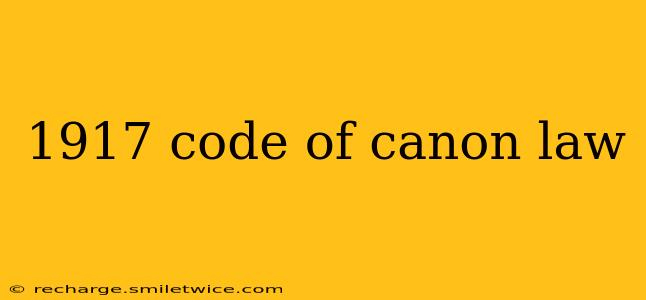The 1917 Code of Canon Law, formally known as Codex Iuris Canonici, represents a landmark achievement in the history of the Catholic Church. Promulgated by Pope Benedict XV on May 27, 1917, and effective May 1918, it codified centuries of canon law, providing a systematic and comprehensive legal framework for the governance of the Latin Church. This code remained in effect until 1983, when it was superseded by the 1983 Code of Canon Law. Understanding its historical context and key provisions is crucial for appreciating the evolution of Catholic jurisprudence.
Why Was the 1917 Code of Canon Law Created?
The need for a unified and codified body of canon law had been felt for centuries. Previous attempts at systematization existed, but they lacked the comprehensive scope and clarity of the 1917 Code. The impetus for its creation stemmed from several factors:
- Desire for Clarity and Consistency: Canon law had evolved organically over centuries, resulting in a complex and often contradictory body of regulations. The 1917 Code aimed to clarify ambiguities, resolve inconsistencies, and provide a single, authoritative source of legal principles.
- Influence of the Napoleonic Era: The Napoleonic Codes, with their emphasis on systematization and clarity, significantly influenced the structure and approach of the 1917 Code. The Church sought to establish a similarly comprehensive and accessible legal system.
- Modernization of Church Governance: The late 19th and early 20th centuries witnessed significant changes in society, and the Church sought to adapt its governance structures to meet the challenges of the modern world. The Code was a crucial part of this modernization effort.
Key Features of the 1917 Code of Canon Law
The 1917 Code introduced several significant innovations in canon law:
- Systematic Organization: Unlike previous collections of canons, the 1917 Code adopted a systematic structure, organizing its provisions into five books covering various aspects of Church life, including general norms, persons, things, processes, and penalties.
- Emphasis on Roman Law: The Code drew heavily on the principles and methods of Roman law, reflecting the Church's longstanding tradition of utilizing Roman legal concepts.
- Comprehensive Coverage: The Code covered a vast range of topics, including the sacraments, liturgical practices, ecclesiastical offices, marriage, and the administration of Church property.
What were the significant changes brought about by the 1917 Code?
The 1917 Code marked a significant shift in the understanding and application of canon law. Some of the key changes included:
- Increased Centralization: The Code strengthened the authority of the Roman Curia and the Pope, centralizing many aspects of Church governance.
- Emphasis on Jurisprudence: The Code emphasized the role of jurisprudence in interpreting and applying canon law.
- Clearer Definitions: The Code provided clearer definitions of key legal concepts, reducing ambiguity and facilitating a more consistent application of the law.
How did the 1917 Code influence the 1983 Code?
The 1917 Code served as the foundation for the 1983 Code. While the 1983 Code introduced substantial changes reflecting the evolving needs of the Church, it built upon the framework and many of the principles established by its predecessor. The 1983 Code addressed many of the criticisms leveled against the 1917 Code, particularly its rigidity and its limited engagement with the changing social and cultural contexts of the twentieth century.
What are some criticisms of the 1917 Code of Canon Law?
While a landmark achievement, the 1917 Code wasn't without its drawbacks. Some criticisms included:
- Rigidity and Formalism: Critics argued that the Code was too rigid and formalistic, hindering the Church's ability to adapt to changing circumstances.
- Clericalism: Some felt the Code reinforced a hierarchical structure that prioritized the clergy over the laity.
- Lack of Participation: The process of drafting the Code lacked significant input from theologians, canonists, and lay people.
Was the 1917 Code ever revised?
No, the 1917 Code was not revised. It was entirely replaced by the 1983 Code of Canon Law, reflecting the Church's ongoing efforts to adapt its legal framework to the needs of the modern world.
This overview provides a general understanding of the 1917 Code of Canon Law. For a deeper understanding, further research into scholarly works on canon law is recommended. The study of this historical document offers valuable insights into the evolution of Church governance and the ongoing dialogue between faith and law.
